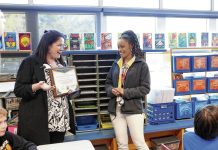Columbia University music professor and Columbus native Brad Garton teaches students just how musical mathematical formulas can be.
The 58-year-old musician and computer engineer has programmed esoteric chaotic math formulas into synthesizers. He has “discovered” the sound of large data sets by compiling statistics into a format that can be converted into music.
One recent project involved translating UFO sighting data into a song. Garton said the result was an ethereal, other-worldly collection of tones.
In Columbus, Garton is perhaps better known as the son of longtime Indiana State Sen. Robert “Bob” Garton and local philanthropist Barb Garton.
[sc:text-divider text-divider-title=”Story continues below gallery” ]
After graduating from Columbus North High School, he attended Purdue University, where he graduated with a pharmacy degree.
He met his wife, Jill Lipoti, while working as a sound ordinance consultant for police departments in southern Indiana. Garton said she pushed him to return to her home state of New Jersey, where he enrolled in the music program at Princeton University, eventually receiving a doctorate.
Along with his musical work, his reach as a university instructor has grown to encompass more than 40 Columbia University computer music centers all over the world. He recently returned from a trip to one of these facilities in Japan, where people were building musical sculptures that integrated sound with visual art.
Before this, Garton was a pioneer in the basic computer codes needed to produce electronic music. His mentor, Paul Lansky, developed some of the earliest music synthesizing software back in 1978.
The software was built in a coding language called real-time cmix (rtcmix), allowing musicians and composers to code compositions into a computer. At the time, the program could not be used live. It was not possible then for a musician to use the software as an instrument in a live performance. The system could only generate music that had already been coded into its memory.
It was also impossible to compose in real time. Instead of hearing the music as it was made, rtcmix required musicians to manually code the songs, then listen later.
In the middle 1990s, together with a team of programmers and engineers from Columbia University, Garton helped to write the additions to rtcmix that changed the computer from a simple playback device into a true instrument.
That code formed the basis of almost all synthetic music programs used since.
Without Garton, there would be no dubstep. Musicians and DJs like Skrillex and Daft Punk would not be able to perform live. There would be no electronica, and popular dance music would probably sound more like it did in 1970.
Engineer, musician or teacher
Garton said his music and computer programming play into each other.For example, he has created a series of books with a soundtrack. As the reader looks through the pages, music plays along. In order to do this, he said, he need to code new functions into rtcmix.
Many of the technical and musical problems he works on now come directly from his students, Garton said.
The students come to him with questions, such as how can a trombone be made to sound like geese flying. Garton said he then helps the students deconstruct each sound into its component parts.
Many of the students also come to Garton with dreams of becoming a DJ or playing popular electronica.
Garton said he’s happy to entertain these dreams, but often he finds that many students outgrow those musical forms.
“Students say I want to be like Skrillex,” Garton said. Skrillex is the stage name of Sonny John Moore, an electronic music producer, DJ, singer and songwriter.
“Well, as my old mentor Milton Babbitt said, ‘Nothing gets old like a new sound,’” Garton said.
Over the years, Garton has composed a huge variety of musical scores ranging from a traditional wedding recessional, which heavily features violins (albeit synthesized violins), to abstract synthesized covers of pop music standards, including Donovan’s “Mellow Yellow.”
He said he never really intended that his programming work would find its way into popular music, but he doesn’t mind.
“I always tell people that I have no musical taste,” Garton said. He’ll listen to anything as long as it’s interesting, he added.
Getting started
“The music bug was always there,” Garton said of growing up in Columbus. “I remember in fourth grade, my parents bought me ‘Switched on Bach,’ which was made on a Moog synthesizer. I knew right away that I wanted to do that.”A Moog synthesizer is an early analog organ simulator built out of keyboards connected by a nest of wires to stacks of amplifiers. It was one of the earliest forms of synthesized music, even though it was recorded directly onto tape like a traditional instrument, rather than into a computer.Back in 1968, there was no computerized music. So Garton had to start his musical career in more traditional fashion with piano lessons.
His teacher, Charlotte Rowe, used a system called the Robert Pace Method. Rather than teaching students to plink away at chopsticks or mimic hand movements, the curriculum focused on teaching the basics of music theory and improvisation.
Garton later met Pace as a colleague at the Columbia School of Music.
Earlier this year, Garton was honored for his contribution to the international presence of Columbia University with the Lenfest Distinguished Teaching Award. The prize entails $25,000 awarded each year for three years. Garton says, while he always keeps an eye looking back toward his roots in Columbus, he’ll be using the money to continue his work and research overseas.
[sc:pullout-title pullout-title=”About Brad Garton” ][sc:pullout-text-begin]
Brad Garton has a pharmacy degree from Purdue University and a doctorate in music composition from Princeton University. He is now director of the Columbia University Computer Music Center program, which serves more than 40 computer music centers worldwide.
Before entering academia, Garton played with several bands in the Indiana. He was known for providing sound effects and keyboard music for West Lafayette punk group Dow Jones and the Industrials.
[sc:pullout-text-end]




